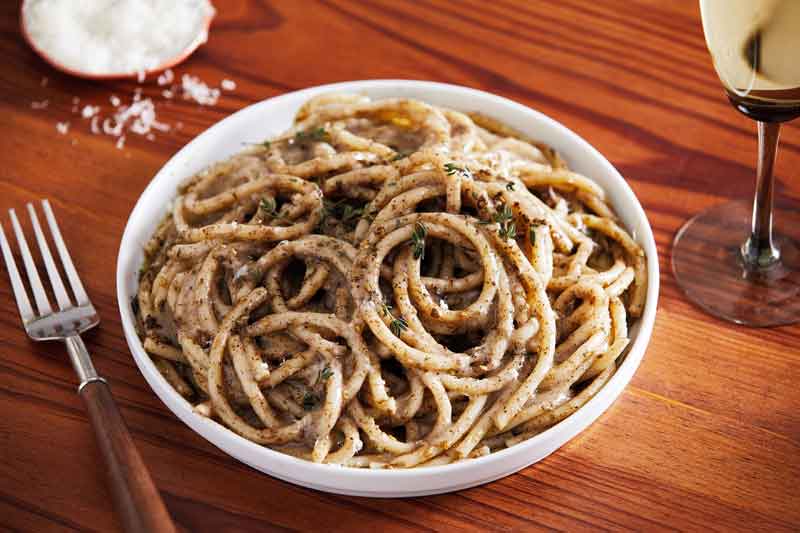 Tom McCorkle for The Washington Post
Tom McCorkle for The Washington Post
There is absolutely nothing wrong with traditional cacio e pepe. Far from it. But - and you knew there'd be a "but," didn't you? - I did come across a recipe recently that makes one small addition to the classic, and it was such a beautiful complement that I knew I'd be making it this way for years to come.
It's from the great and powerful Yotam Ottolenghi's new book with Ixta Belfrage, "Ottolenghi Flavor." The London-based Israeli chef has brought new awareness of Middle Eastern ingredients to countless readers with his previous bestsellers, including "Jerusalem," "Ottolenghi," "Plenty" and "Plenty More." So it fits perfectly that he would try sprinkling one of his favorite spice blends - and as I'm a fellow Middle Easterner, one of mine - onto the Italian classic.
Za'atar is a blend of woodsy herbs such as thyme, marjoram, oregano and/or hyssop, sumac and sesame seeds that varies widely throughout the Middle East. As Ottolenghi writes, za'atar "doesn't take anything away from the much-admired simplicity of the dish. All it does is add a layer of delicious herbiness that goes hand in hand with the pepper and the cheese."
He and Belfrage have also perfected the techniques giving you a super-silky sauce that doesn't separate - one of the risks when making cacio e pepe. They're not the first to suggest that you cook the pasta in a much smaller-than-usual amount of water, then to use that super-starchy water to emulsify the sauce. But this was the first time I had tried it, and it worked wonderfully. (Making sure you grate the cheeses very finely - I used a Microplane for that - and adding them in batches also helps.)
You purists, if you're still reading at this point, might have noticed that I said "cheeses." It's true: Traditional, original Roman-style cacio e pepe depends on the use of just one cheese, pecorino Romano. Some recipes sneak in a little Parmesan, which makes perfect sense since some restaurants in Rome toss the pasta table-side in a hollowed-out wheel of Parmesan. Ottolenghi's version flips the proportions of cheese, using four parts Parm and one part pecorino. You can feel free to flip it back or even to use all pecorino if you want.
But don't get this twisted: Ottolenghi knows his stuff. His father is Italian, his name is Italian and, according to a 2009 article in Gourmet, "his grandmother re-created her own private Little Italy in her Tel Aviv suburb." That's all to say that when it comes to this staple of modern Roman cooking, as is the case with so many other dishes, the Ottolenghi way simply works.
ZA'ATAR CACIO E PEPE
ACTIVE: 15 minutes | Total time: 30 minutes
SERVINGS: 4 to 6
Za'atar, the Middle Eastern spice blend, adds a layer of herbaceousness to the simple and classic Italian pasta of cheese and black pepper. To get the sauce super-smooth, grate the cheese as finely as possible (using a Microplane-style grater), and cook the pasta in a wide pan with much less water than usual. The latter technique packs the cooking water with starch, which is key to emulsifying the sauce.
Ingredients
• 7 cups water
• 3/4 teaspoon fine sea salt, plus more for finishing
• 1 pound dried bucatini (or other long pasta, cooking time adjusted if necessary)
• 4 tablespoons unsalted butter
• 1 tablespoon plus 2 teaspoons za'atar, divided
• 2 teaspoons freshly cracked black pepper
• 4 ounces Parmesan cheese, very finely grated
• 1 ounce pecorino Romano cheese, very finely grated
• 2 teaspoons whole fresh marjoram or thyme leaves (optional)
Steps
In a deep, wide skillet or Dutch oven over medium-high heat, bring the water to a boil, then stir in the salt. Add the bucatini and cook for 9 minutes (or per package instructions) until al dente, stirring every now and then so they don't stick together or to the bottom of the pan, and to ensure they are submerged. Add hot water if necessary to keep the pasta covered. Drain, reserving all the cooking water. (You should have about 2 1/4 cups water; if not, add enough hot water until you do.)
In a large, high-sided, nonstick saute pan over high heat, cook the butter until bubbling, then stir in 1 tablespoon of the za'atar and the pepper and cook, stirring, until fragrant, about 1 minute. Add the reserved cooking water, bring to a rapid boil and cook until silky and slightly reduced, about 5 minutes. Add the pasta and stir vigorously into the sauce. Add the Parmesan in two batches, continuing to stir vigorously as you go and waiting until the first half has melted before adding the next. Once all the Parmesan has melted, add the pecorino, continuing to stir, until it has also melted and the sauce is smooth and silky.
Transfer the pasta to a lipped platter and sprinkle with the marjoram or thyme (if using), remaining 2 teaspoons za'atar and a small pinch of salt. Serve hot.
Nutrition (based on 6 servings) | Calories: 387; Total Fat: 12g; Saturated Fat: 7g; Cholesterol: 28mg; Sodium: 547mg; Carbohydrates: 58g; Dietary Fiber: 3g; Sugar: 4g; Protein: 11g.
Adapted from "Ottolenghi Flavor" by Yotam Ottolenghi and Ixta Belfrage.
(Buy it at a 40% discount! by clicking here or order in KINDLE edition at a 57% discount by clicking here. Sales help fund JWR.)
JewishWorldReview.com publishes delicious -- mostly nutritious -- recipes. Sign up for the daily JWR update. It's free. Just click here.
(COMMENT, BELOW)


 Contact The Editor
Contact The Editor
 Articles By This Author
Articles By This Author